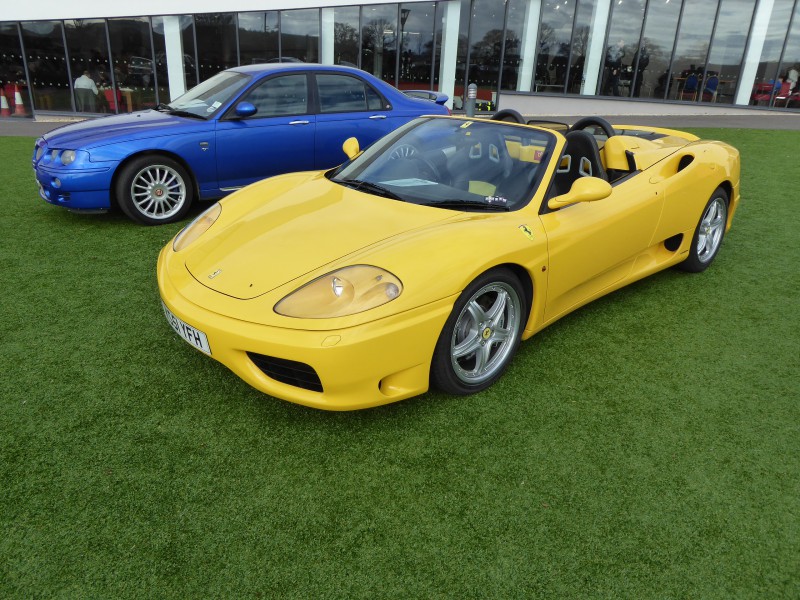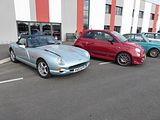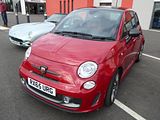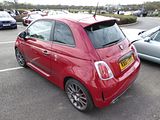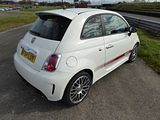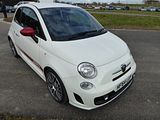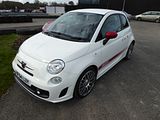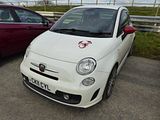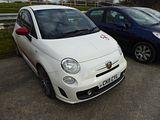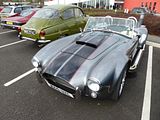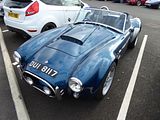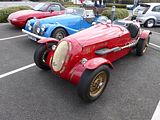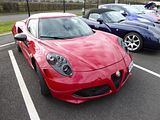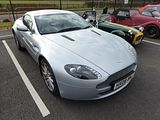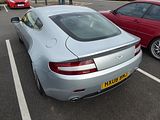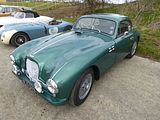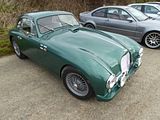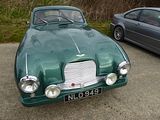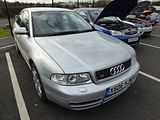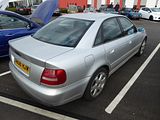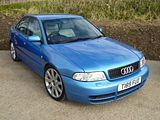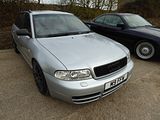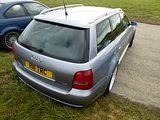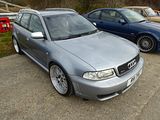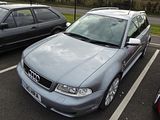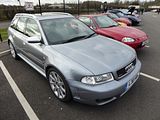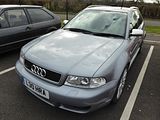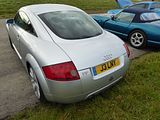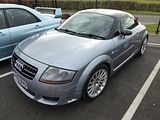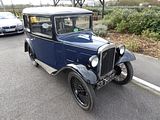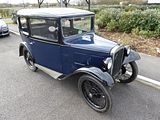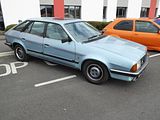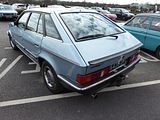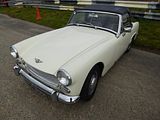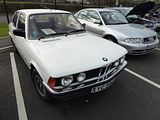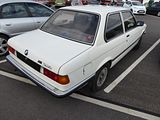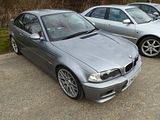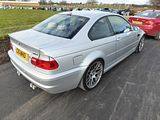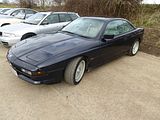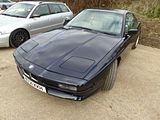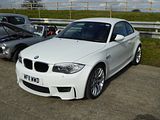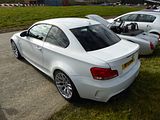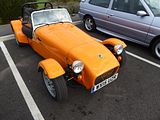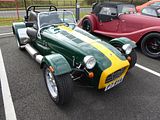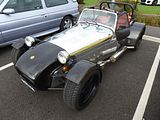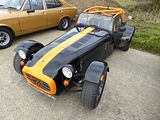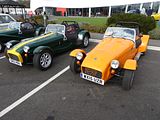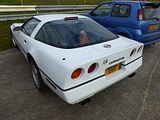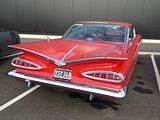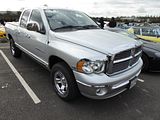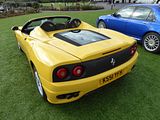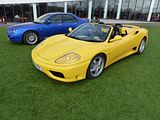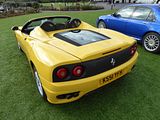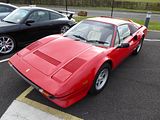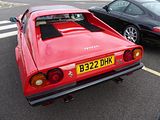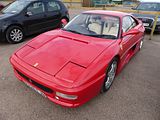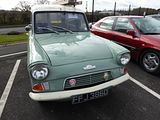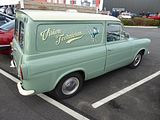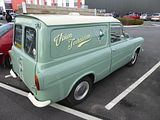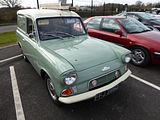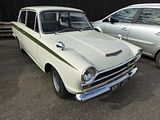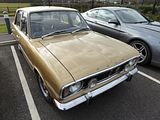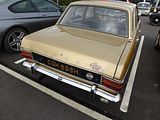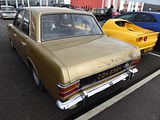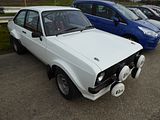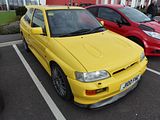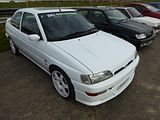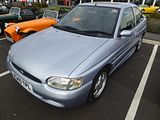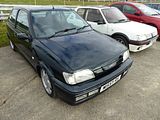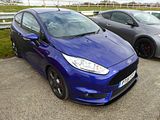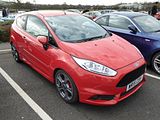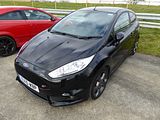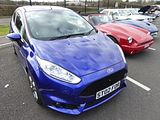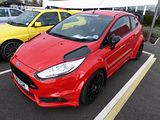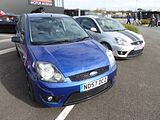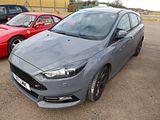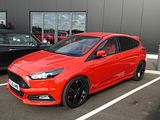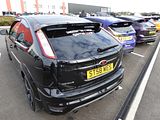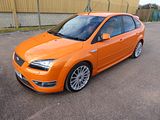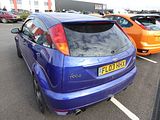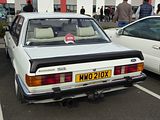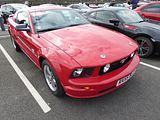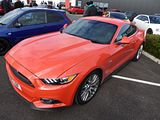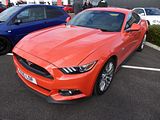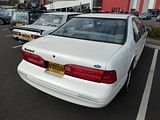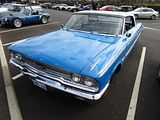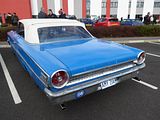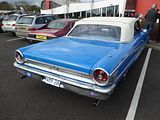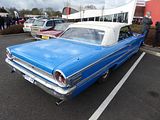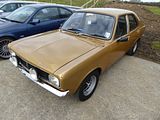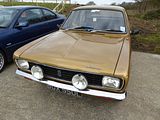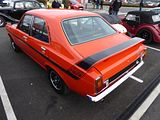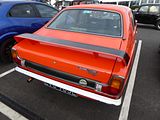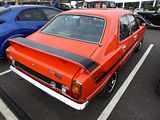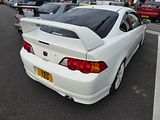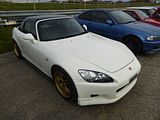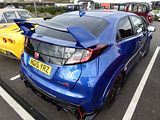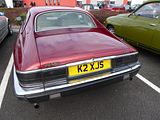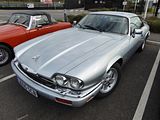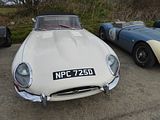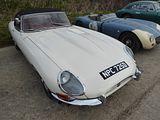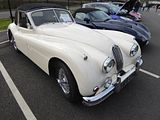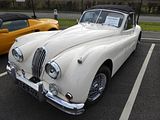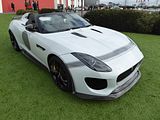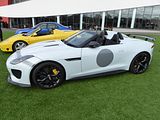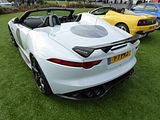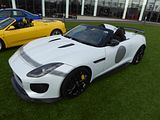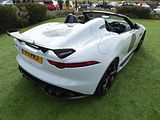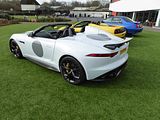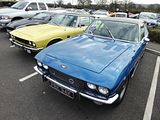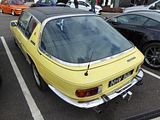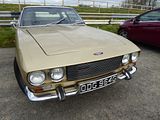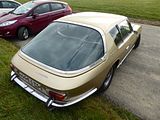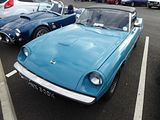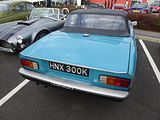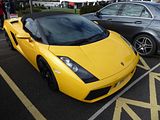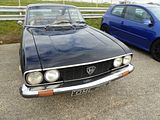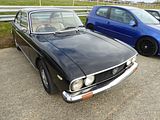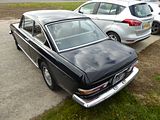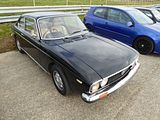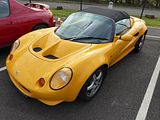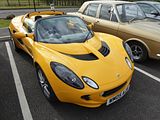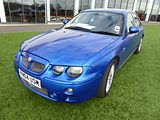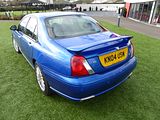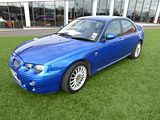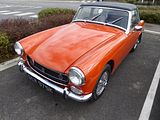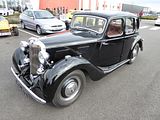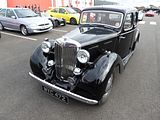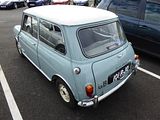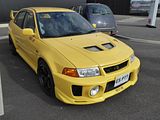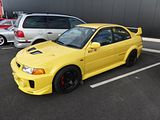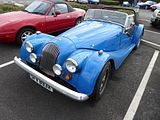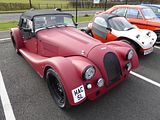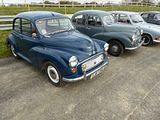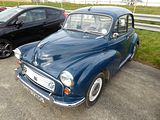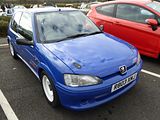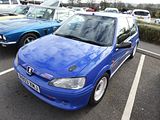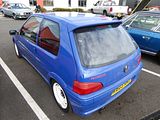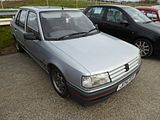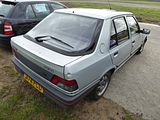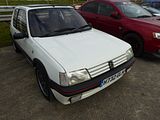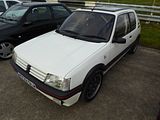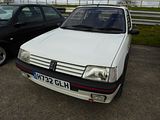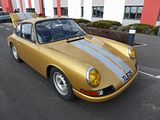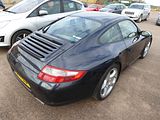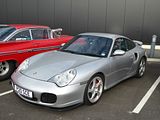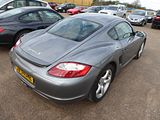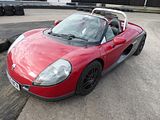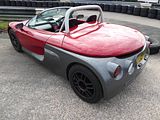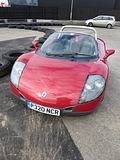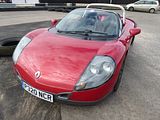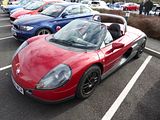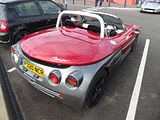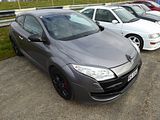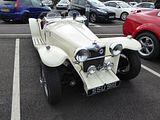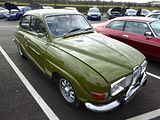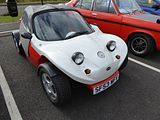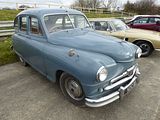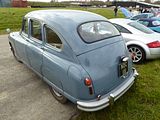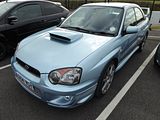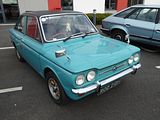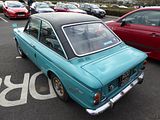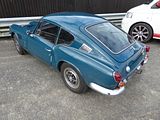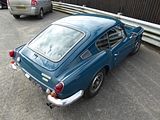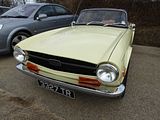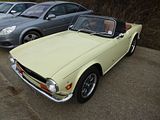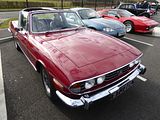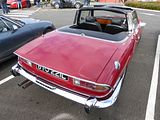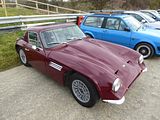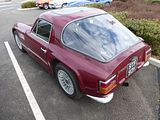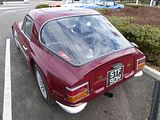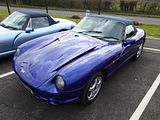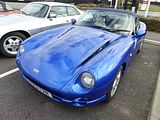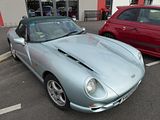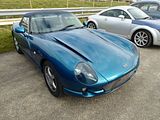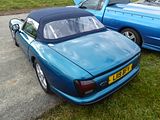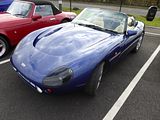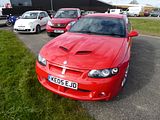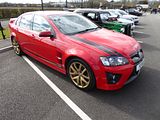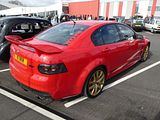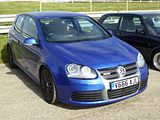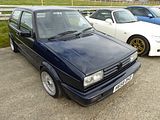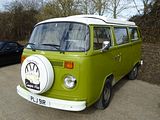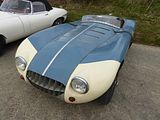Five years ago, the Breakfast Club was a regular for car enthusiasts to gather and show off and admire each others’ automotive treasures that was associated – in the UK – with Goodwood. Free to attend, and with a declared theme each month, word soon got out that it was worth getting up early and going along, as there would likely be all manner of interesting and rare cars on display. It did not take long before conceptually similar events started to spring up around the country, and each that I am aware of seems to have enjoyed an explosive growth of interest that often means the venue struggles to cope with the crowds and the volume of cars. The Haynes Motor Museum threw their hat into the proverbial ring at the start of 2015, holding their first such meeting in February of that year. Haynes’ location is in some ways not ideal, as it is what seems like in the middle of nowhere, in Somerset, just off the A303, and about 20 minutes south of Shepton Mallett, or an hour from Bristol, but the venue has the twin advantages of plenty of space and a fascinating museum on site for those who want somewhere to escape the elements, or to stay longer, should the coffee shop not suffice. Wisely, the first Sunday of the month was selected, so the event does not clash with the extremely popular Queen Square Bristol meet. I attended the first couple, and enjoyed them, as although some of the cars (and hence people) were the same as you find in Bristol, there were plenty of cars which live south of the venue for whom Bristol is just too far away. On neither occasion was the event really busy, though, and I did wonder how it would develop in the ensuing months. There did not seem to be that much coverage online to give me many clues, but it was fairly clear that the events were still happening, so when I found a free first Sunday in March, and wanted a local-ish event as I could see a gruelling week ahead of me with a trip to the Geneva to be followed by a work trip to Dublin, an hour’s travel each way down to Sparkford seemed ideal. The event officially starts at 9am, but knowing how these things turn out, I thought I would try to get there a little before that. It was when I got the traffic lights on the main road that goes round Castle Cary that I first spotted a couple of cars that were likely headed in the same place as me, and I followed them the last few miles, to arrive at the Museum only to find what looked like a pretty full forecourt. There is a large area in front of the Museum, and even at 8:45, it was more or less full. I got one of the last spaces, which meant that all subsequent arrivals, of which there were plenty, ended up parking in a long line in the area adjoining the small test track. It was clear that things have certainly moved on from my last visit a year ago and that even though this was far from a warm spring morning (though it least it did stay dry), there were plenty of people eager to get out, show off their car and look at what others had brought. As is the case with events like this, although I made several tours of the assembled cars, there are inevitably some that were present, which I missed. But there are plenty that I did see, as the 225 photos in this report will evidence.
ABARTH
Initially my 595 Competizione was the only Abarth present, but during the morning two more arrived. Both were white cars, and they had to park in the side area, so we never got all three of them together. One of them belonged to the couple who go by the name “Mudskipper” on the various Abarth Forums, whilst I don’t know who owns the other one, and I did not see the driver get in or out of it.
AC
The Cobra remains a very popular choice among those who like a raw sports car, and there are still companies producing replica versions of the original machine, a design which has already celebrated its 50th birthday. There were a couple of them here, and despite the fact that they are quite a common sight at events like this, they are still crowd pullers, especially when the owner gets in and fires the engine up.
ALFA ROMEO
One of the earliest arrivals of the day, so he told me, was David Roots in his Alfa Special, which gave him a parking position right in the centre of the event. His car was, as is always the case, attracting lots of interest, with plenty of attendees who clearly have not seen it before, even though he regularly comes to events at Haynes as well as the Bristol Breakfast Club meetings. For those who are wondering, it is officially an Alfa Special, designed as an homage to the 1935 8C Tipo C 35 Monoposto. Just eight of these cars, with a larger 3.8-litre version of the famous Jano designed engine, sharing no castings with the earlier blocks, were individually built for racing in five months, as raced by Scuderia Ferrari. The 3.8 produced 330 bhp at 5500 rpm, and had 320 lb·ft from 900 to 5500 rpm., and 15.5-inch drum brakes all round. Though not a match for the big Mercedes and Auto Union on the faster circuits, they came into their own on the tighter circuits and races. The last time one came up for sale, in September 2013, it was the former Scuderia Ferrari 8C 35, in which Tazio Nuvolari had won the 1936 Coppa Ciano, and it sold for £5.9 million; a new world record price for any Alfa Romeo. Given the rarity of the car and the way prices have rocketed in recent years, ti is a fair guess that a genuine 8C like this would now have 8 digits in the price tag. Like many of us, David dreamed of owning a car like the original, but unlike most of us, he did the next best thing to paying the millions and decided to create his own. Back in 1989, somewhat deterred by the thought of the hours that could be spent lying underneath a rusty wreck at the side of the road, missing some obscure part that would need to be made specially. He decided to opt for a special combining retro styling with new bodywork and reasonably modern mechanics. A company called Classic Specials created that something, combining a bespoke chassis utilising MGB mechanics with a Lenham Healey bodyshell. Ten years later, in 1999, at the Castle Combe Classic Action Day he ‘blew’ the trusty B Series engine and that was the turning point which caused him to wonder if he could not actually design his own car. Many of us dream of doing this, but he actually decided to set about the task. Utilising the MG-Lenham chassis and Lenham Healey rear bodywork, the MG engine and gearbox were replaced with those from a 1969 Alfa Romeo 1750 GTV. Then a body had to be designed and constructed. This was done by making a buck from the aeroscreens forward, which was used to make a mould and moulding. Whilst it is not a precise rendering of the classic Tipo C, the result looks very professional, and the car always attracts attention wherever it is shown.
The only other Alfa here was far more recent, a 4C Competizione. The car seen here is a Launch Edition and I recalled seeing it at this event when I last attended a year ago. Its owner clearly remembered me, too, as in fact I saw before I saw his car, as he happened to be in the area where I was parking my car. He did spot that my car was different from last time I had seen him, whereas he is still enjoying his. Very much so, he said, which rather proves that although the press have been less than enthusiastic about this car, that there is no substitute for trying it yourself before reaching your conclusions!
ASTON MARTIN
Two very contrasting models bearing the Aston Martin badge were here. The more recent model is the V8 Vantage, a car which has now been in production for 10 years and of which Aston have sold several thousand. A more affordable entry model than had been available before, the car has gradually moved up-market during its production life, as more powerful V12 engines have been put under the bonnet, but you can still buy the original V8 model if you so desire.
In contrast, this glorious DB2 shows the first new post-war Aston style. and this was the first car to adopt the now legendary DB naming convention, reflecting the fact that in 1947 David Brown had bought the Aston Martin and Lagonda companies and incorporated them as Aston Martin Lagonda Ltd. Lagonda’s 2.6 litre dual overhead cam, straight-six engine, more powerful than the pushrod 1.9 litre unit in the Aston Martin 2-Litre Sports, was the main objective in Brown’s acquisition of the company. W. O. Bentley had supervised the engine’s design, which was largely by William (Willie) Watson, an engineer with the pre-war Invicta company who had collaborated on Lagonda’s pre-war V12 and also designed the short-lived post-war version. Work then started on producing a new car, which was called the DB2. This new model would utilise a version of the Lagonda engine in a shortened version of the tube-frame chassis designed by Claude Hill for the Aston Martin 2-Litre Sports, with a fastback coupé body designed by Frank Feeley. Three pre-production cars were entered for the 1949 24 Hours of Le Mans. One, which would become the development car for the production DB2, had the Lagonda straight-6, while the four-cylinder Aston Martin 2-litre unit powered the other two. After six laps the Lagonda-powered car, driven by Leslie Johnson, retired with overheating caused by failure of the water pump. One of the 2-litre cars was in 4th place and running without brakes when it crashed two hours short of the finish, fatally injuring driver Pierre Maréchal. The other finished 7th, crewed by Arthur Jones and Nick Haines. A month later, the larger-engined car, driven by Leslie Johnson and Charles Brackenbury, finished 3rd in the Spa 24-hour race, where one of the 2-litre cars was driven to 5th by Nick Haines and Lance Macklin. For 1950 all three factory team cars were equipped with the Lagonda engine. At the 1950 Le Mans race the one driven by George Abecassis and Lance Macklin finished 5th, with Brackenbury and Reg Parnell bringing another home 6th, which won Aston Martin 1st and 2nd in the 3-litre class. Across the Atlantic, Briggs Cunningham drove his DB2 to 2nd in its class at the inaugural Sebring race meeting in December 1950. The factory team cars continued racing in Europe throughout 1951, including at Le Mans, where Macklin and Eric Thompson took 3rd overall, with Abecassis and Brian Shawe-Taylor 5th. David Brown soon embarked on a series of Aston Martins designed specifically for competition use, starting with the DB3. Meanwhile, the production DB2 debuted at the New York Auto Show in April 1950 and continued in production until April 1953, by which time 411 had been made. The first 49 had a chrome-framed front grille in three separate parts, and large rectangular cooling vents in the front wings. Subsequent cars had a one-piece grille with horizontal chrome slats, and no side vents. The single-piece bonnet was hinged at the front. At the rear of the fixed-head coupé (FHC) a small top-hinged lid gave access to the spare wheel, and luggage space was behind the front seats, accessible only from inside the car. Later in 1950, a Drophead Coupé (DHC) variant was introduced. At least 102 were built. In April 1950, an engine with larger carburettors, inlet camshaft the same as the exhaust (for increased duration), and higher compression ratio pistons (8.16:1) was made available. Aston Martin’s first Vantage upgrade option offered 125 hp. Initially the higher compression ratio made the engine unsuitable for the British market, as the postwar austerity measures of the early 1950s restricted UK vehicles to 72 octane “Pool petrol”. The first DB2 Vantage, LML 50/21, was delivered to, and raced by, Briggs Cunningham in the United States. A revised version of the DB2 was launched in 1953, called the DB2/4. It was available as a 2+2 hatchback, marketed as a Saloon, as a Drophead Coupé (DHC) and as a 2-seat Fixed Head Coupe. A small number of Bertone bodied spiders were commissioned by private buyers. A further update in 1957 created the Mark III, and this was produced until the launch of the DB4 in 1958. A car similar to this sold for £180,000 at Silverstone Auctions at the Race Retro event the weekend before. I can’t imagine that these car will stay this “cheap” for much longer. It was certainly a Star Car for most people here.
AUDI
I was amazed to find that there no fewer than 5 examples of the B5 gen fast Audi present. Three of them were S4 models – 2 Saloons and an Avant – and two were the more extreme RS4 Avant cars. As a previous owner of one of the S4 Saloons, I have a very soft spot for these cars. The S4 – the second model to bear the name after it was used on a potent version of the Audi 100 between 1991 and 1995 – was launched in the autumn of 1997, with an Avant version joining it a year later. The car boasted a twin turn 2.7 litre V6 engine, generating 265 bhp, coupled to a 6 speed manual gearbox, standard Quattro all wheel drive transmission, larger 17″ wheels sitting in flared wheel arches, which made the car identifiable if you had not selected one of three S4-exclusive colours, as well as upgraded suspension and brakes. With a top speed limited to 155 mph and 0 – 60 time of 5.6 seconds, it was among the fastest saloons on the market at the time, and a real rival to the BMW M3. I loved mine in the 30 moinths I had it, and it went on to serve a colleague well, who kept it for many years until with over 160,000 miles on the clock, a tree fell on it crushing the roof on one stormy night. The RS4 was even more special, of course. This dates from an era when Audi only produced one RS model at a time, meaning that the variant had quite a short production life. Introduced by Audi in late 1999, for main production and sale from 2000, this was effectively the successor to the Porsche / quattro GmbH joint venture-developed Audi RS2 Avant that was sold in the mid 1990s. Like its RS2 predecessor, it was available only as an Avant. Although related to the Audi B5 S4, many of the outer body panels were altered, with wider front and rear wheel arches, to allow for the wider axle track on the RS 4. With unique front and rear bumpers and side sills, and the rear spoiler from the S4 Avant, the aerodynamic modifications achieved a drag coefficient of Cd 0.34 and a very purposeful look, especially when finished in a sober colour such as the two examples seen here. It was the mechanical changes, though, which had the huge difference. The engine was developed from the 2.7 litre V6 ‘biturbo’ used in the B5 S4, and retained the same 2,671 cc capacity, but much was changed. Developed and manufactured in the UK by Cosworth Technology, it featured enlarged intake and smaller exhaust ports on the two Cosworth cast aluminium alloy cylinder heads, two parallel BorgWarner turbochargers, two larger side-mounted intercoolers, dished piston crowns, stronger connecting rods, larger intake ducting, enlarged exhaust system, and a re-calibrated engine management system. The modifications increased the engine’s output from 265 bhp to 375 bhp at 7,000 rpm, and with 325 lb/f·ft of torque. The engine was controlled by a Bosch Motronic ME 7.1 electronic engine control unit (ECU), using a Bosch ‘E-Gas’ electronic drive by wire throttle. The engine had multipoint sequential fuel injection, a MAF, six individual single-spark coils and NGK longlife spark plugs. The engine oil was cooled by a dual oil:water cooler and an oil:air cooler. There was a 6 speed manual transmission and Audi’s Torsen-based quattro system. Even with a kerb weight of 1,620 kilograms (3,571 lb), the RS 4’s powerful engine gave it the performance of a sports car. 100 km/h could be reached from rest in 4.9 seconds, 160 km/h in 11.3 seconds, and 200 km/h in 17.0 seconds. Top speed was electronically limited to 262 km/h(162.8 mph) Audi produced 6,030 units between 1999 and 2001. Many have suggested that these B5 generation Audis are a future classic and maybe that time is now here. Perhaps I should have hung onto mine?
Also tipped for future classic status is the first generation TT and there were a couple of models here. One was the regular Coupe model, and the other was an example of the limited edition 225 Sport, one of 800 such cars that were sold in the UK in 2005, a year before the debut of the second generation model. The Sport had a power increase from 225 of the regular car to 237 bhp, thanks to a larger turbo and a number of weight saving measures which ranged from deletion of the rear seats and the spare wheel and the standard air conditioning. Distinguishable from other TT Coupés by its two-tone paint scheme, with a Phantom Black pearl painted roof, pillars and mirror housings, there was a choice of Avus Silver, Phantom Black, Mauritius Blue or Misano Red for the main body colour and unique 18″ 15-spoke cast aluminium alloy wheels plus the same body kit as fitted to the TT 3.2 V6, along with black exhaust tailpipes made the car easy to identify.
AUSTIN
Oldest car of the day, and one needing little introduction was this Austin Seven, Herbert Austin’s 1922 masterpiece which more than any other car can claim to be responsible for putting Britain on wheels. The Seven would go on to be produced for 17 years, with production ceasing in 1939, and during that time the car evolved notably from those early cars, as well as appearing in countless different body styles.
Far less familiar, but very splendid was this Six. Austin made a range of these large models throughout the 20s and early 30s, and quite a few have survived. There were lots of different versions offered. most of them named after places in the UK. I am not sure quite which version this one is, but it was very splendid.
Ironically, considering it is around 60 years their junior, the final Austin here is probably the rarest of the cars bearing badge to be present. I heard several people admit that they did not know what it was, but there were also plenty who knew only too well, and sadly most of whom had less than completely positive memories of the car from when it was new. It is of course and Ambassador and is seen here in near top of the range 2.0 HLS guise, also sporting a few adornments which were not standard fit, such as the driving lamps recessed in the front grille. When it was launched in March 1982, everyone said that this was the car that the Princess should always have been from launch, as it had the hatchback that the steeply sloping rear end suggested was always there. It is still not clear why Harris Mann’s boldly styled ADO71 car, the 18-22 Series which was quickly rechristened the Princess, went into production with a small boot opening instead of the more useful large rear tailgate. By the time the Ambassador was launched in March 1982, the Princess had been on sale for 7 years, and so even a comprehensive facelift, which is what this change was – despite the fact that all the body panels apart from the front door skins were apparently new – could not really hope to compete against the recently launched all-new Vauxhall Cavalier or even Ford’ Sierra which would arrive later in the year. The Ambassador did have roominess on its side, with a lot of space for rear passengers, but it also had BL Build Quality, and some of the cars proved to be not particularly reliable. The 2.2 litre E Series 6 cylinder engine was not offered, meaning that Ambassadors only came with the O Series engine, in 1700 and 2000cc guise. Top spec models, the HLS and Vanden Plas had a twin carburettor engine, but even these did not have a 5 speed gearbox, which was fast becoming a necessity for cars in this class. That coupled with the fact that the cars were not very inspiring to drive meant that despite the fact that the top spec cars were quite well equipped and nicely trimmed inside, the model’s appeal was limited. The Ambassador was only ever going to have a short life, as it was deleted once the Austin Montego hit the market in April 1984. Although engineered for left and right hand drive, only right hand drive models went into production, so the car was only sold in the UK. 43,427 were built in the two years which it was available, of which only a handful are still on the road, with a few more in SORN status.
AUSTIN-HEALEY
The first significant update to the second generation Sprite, the one which had spawned the visually similar MG Midget, came in the autumn of 1966, with the launch of the Mark III. The Mark III retained the 1098 cc, A Series engine, but it had a stronger block casting, and the size of the crankshaft main bearings was increased to two inches. A new (slightly) curved-glass windscreen was introduced with hinged quarterlights and wind-up side windows. Exterior door handles were provided for the first time, with separate door locks. Though the car could now be secured, with a soft-top roof the added protection was limited. The rear suspension was modified from quarter-elliptic to semi-elliptic leaf springs, which gave a more comfortable ride for a near-negligible weight penalty as well as providing additional axle location, the upper links fitted to the quarter-elliptic models being deleted. Though scarcely sybaritic, these changes helped the Sprite and Midget compete with the recently released Triumph Spitfire. 25,905 Mark III Sprites were made before the Mark IV model was released in 1966, with a more powerful 1275cc engine and other changes.
BMW
When I first saw this E21 3 series, I assumed it must be a 320 or 323i, as it had twin headlights. But the badge on the back said 316, which was the entry level model, notable for its extremely limited standard equipment levels, which only had single round units. An information plaque in the car did mention that it is indeed a 316 but with some upgrades including those extra lights. The E21 dates from an era when BMWs, even 3 series models, were out of reach of most people, costing far more than regular brands, the one we would now think of as the non-premium ones, but the tide was changing, and BMW introduced a revised 316 model, with a 90 bhp 1800cc version of the M10 engine to replace the earlier 1600cc car, with the aim of luring company car drivers who wanted “the ultimate driving machine”. As standard you got a four speed gearbox, and there was no radio, so whilst the pricing initially looked competitive, you were getting a very spartan, if beautifully finished car. This generation 3 Series was also not universally loved for its handling, though it was the potent 323i where the snap-on oversteer was the problem rather than this relatively low powered model. There are not many E21s left from the 1,364,089 which were built.
Showing the evolution of the 3 Series, there were a couple of examples of the E46, the fourth generation of the model, but still recognisably from the same stable as that 1975 Paul Bracq styled car, seen here in much loved M3 guise. Although successive M3s have got ever faster and more sophisticated (and costly), many will opine that the E46 is the very best of all.
The 840Ci may have had a V8 unlike the earlier 850CSi version which was endowed with the V12, but talking to the owner, after telling him just how good his car sounded as he drove up, it would seem that actually this is the version to have. He’s owned this car for a number of years, and says that he is watching as the market gradually wakes up to the merits of this car, and prices start to rise.
A BMW that hit the spot when new, and in which interest has not faded since, is the 1M Coupe, a car which BMW were at pains to say was a true M car, but which found plenty of fans among those who managed to secure one from its short production run. More often seen in the signature Volcano Orange, white rather suits it as well.
CATERHAM
Caterham owners are a hardy lot, and given the biting wind that was keeping temperatures on the refreshing side during this event, that would be just as well, but the trade off for having to wrap up a bit would be the chance to enjoy a fun machine such as the Seven on the bendy roads that surround the Museum. There were at least 5 different models here.
CHEVROLET
Three very different Chevrolets were here. Most familiar to UK eyes would be this C4 generation Corvette. An all new design that appeared in 1983, replacing the C3 model which ran for 15 years, this car then went on to enjoy a long and successful career in its own right, with open topped and progressively more powerful models joining the range over the years.
Dating from the same era was this El Camino. Chevrolet first used the name in 1959 when they produced a rival to the Ford Ranchero which had debuted a couple of years earlier, with a pick-up version of their large full-sized Bel Air and Impala saloons, and then following a gap of a few years, from 1964 the name saw continuous services right through to the end of production of the model seen here, in 1987. This is an example of the fourth style to bear the name, and it first appeared in 1978, based on the new mid-sized Malibu. The 1978 through 1987 El Caminos were produced in four trim levels: Classic, Black Knight (1978)/Royal Knight (1979–83), Conquista and Super Sport, and shared chassis components with the Chevrolet Malibu. Chevrolet 90° V6 and Buick V6 engines were used for the first time. The optional 305 cubic-inch small block V8 was rated at 150 or 165 hp, and from 1982–1984, the Oldsmobile-sourced Diesel engine was also optional. The front end sheet metal and doors were shared with the Malibu, and the rear tailgate and bumper was shared with the Malibu station wagon. For the first time, though, the El Camino had a unique chassis , shared with no other Chevrolet. The front end featured a new single rectangular headlight design. The base engine was a 3.3 litre V6 that developed 95 hp except in California where, to meet emissions standards, the larger 231-cubic-inch Buick engine was the base engine . Two upgrades could be ordered: a 305-cubic-inch V8 with 145 hp, or a 350-cubic-inch V8 with 170 hp that was only available in El Caminos and Malibu station wagons. It was not available on Malibu passenger cars (with exception to coupe and sedan Malibu 9C1 police vehicles). Among GM makes, at least, the era of bigness was fading into history, overtaken by a new age of efficiency and economy. The 1979 model got minimal changes following its debut as a redesigned “new-size” model in 1978. Alterations to the 1979 El Camino amounting to little more than a new divided grille. However, a “small-block” 267-cubic-inch (4.4-litre) V8 joined the options list and slotted between the standard 3.3-litre V6 and the optional 5.0-litre four-barrel V8. The 350-cubic-inch (5.7-litre) V8, developing 170 hp was again available. Both three- and four-speed manual transmissions had floor shifters. The 1980 El Camino started out the 1980s with few changes, though engine choices were shuffled a little. The base V6 displaced 229 cubic inches, up from 200 the year before. Horsepower increased from 94 to 115. Optional again were a 267-cubic-inch V8 with 125 hp and a 305 V8, now with 155 hp (down five). The 350 with 170 hp offered in 1979 was dropped. A three speed floor shifted manual transmission was standard, but most got the optional three-speed automatic. The 1981 models received a new horizontal tube grille. The 1981 engines mostly continued from 1980, but now used GM’s Computer Command Control (CCC) emission system. The base 229-cubic-inch V6 made 110 hp (down from 115), as did the California-only 231-cubic-inch Buick V6. Optional engines were the 267-cubic-inch V8 with 115 hp and the 305-cubic-inch V8, now with 150 hp. The three-speed automatic added a lock-up torque converter to aid highway mileage. The 1982 (through the final 1987) El Camino sported a new frontal appearance with a crosshatch grille flanked by quad rectangular headlights. New under the bonnet for 1982 was a 105 hp 5.7-litre Diesel V8, which was also offered in Chevy’s full-size cars. Though mileage with the diesel was commendable, it was an expensive option and would eventually amass a dismal repair record. Petrol engine choices were unchanged, except Chevy’s 3.8-litre V6 was now standard in California-bound cars, replacing Buick’s 231-cubic-inch V6. In 1983, the 4.4-litre V8 was gone, leaving the 5.0-litre version as the only optional gas V8. The standard engine was again Chevy’s 3.8-litre V6 with 110 hp, though California cars, once again, got a Buick V6 with similar specifications. Continuing on the options list was the 5.7-litre V8 Diesel with 105 hp. The sister Malibu sedan and wagon were discontinued after the 1983 model year. The 1984-87 El Camino SS was offered as a conversion (completed by Choo-Choo Customs Inc., of Chattanooga, Tennessee) to include the aerodynamic front end similar to the Monte Carlo SS, but did not receive the L69 engine package. For 1985, GM shifted El Camino production to Mexico, and the new 4.3 litre was standard through 1987.
Final Chevrolet here was a 1959 Impala Coupe, from the year when the tail fins reached their most dramatic ever seen. The Impala name had been seen for the first time in 1958, when it was applied to a new top of the range model. For 1959, Chevrolet redesigned their entire range. Sharing bodyshells with lower-end Buicks and Oldsmobiles as well as with Pontiac, part of a GM economy move, the Chevrolet’s wheelbase was 1-1/2 inches longer. Using a new X-frame chassis, the roof line was three inches lower, bodies were two inches wider, and curb weight increased. Its tailfins protruded outward, rather than upward. The taillights were a large “teardrop” design at each side. The Impala became a separate model series, adding a four-door hardtop and four-door sedan, to the two-door Sport Coupe and convertible. Sport Coupes featured a shortened roof line and wrap-over back window. The standard engine was an inline 6, while the base V8 was the carryover 283 cu in (4,640 cc), at 185 hp. Optional were a 283 cu in with 290 hp and 348 cu in (5,700 cc) V8 up to 315 hp. Standard were front and rear armrests, an electric clock, dual sliding sun visors, and crank-operated front vent windows. A contoured hooded instrument panel held deep-set gauges. A six-way power seat was a new option, as was “Speedminder”, for the driver to set a needle at a specific speed and a buzzer would sound if the pre-set was exceeded. The 1960 Impala models reinstated three round taillights on each side, a nonfunctional front air intake scoops, and a white band running along the rear fender, and the model was then replaced by an all new series for 1961.
DODGE-RAM
One of the largest vehicles present was this Ram 1500 Pickup
FERRARI
This stunning 360 Spider was one of a trio of cars which was selected by the organisers for prime position on the lawn area.
Tougher emissions standards in the 1980s challenged Ferrari more than many other marques. In 1980, fuel injection was adopted for the first time on the 308 GTB and GTS models, and power dropped quite noticeably fro 240 bhp to 214bhp. Two years later, at the 1982 Paris Motor Show, Ferrari launched the 308 quattrovalvole, in GTB and GTS form. The main change from the 308 GTBi/GTSi it succeeded were the 4-valves per cylinder—hence its name, which pushed output back up to 240 hp restoring some of the performance lost to the emission control equipment. The new model could be recognised by the addition of a slim louvred panel in the front lid to aid radiator exhaust air exit, power operated mirrors carrying a small enamel Ferrari badge, a redesigned radiator grille with rectangular driving lights on each side, and rectangular (in place of round) side repeaters. The interior also received some minor updates, such as a satin black three spoke steering wheel with triangular centre; cloth seat centres became available as an option to the standard full leather. Available included metallic paint, a deep front spoiler, air conditioning, wider wheels, 16-inch Speedline wheels with Pirelli P7 tyres, and a satin black roof aerofoil (standard on Japanese market models). Apart from the 32-valve cylinder heads, the V8 engine was essentially of the same design as that used in the 308 GTSi model. The gear and final drive ratios were altered to suit the revised characteristics of the four valves per cylinder engine. One other significant benefit of the QV four valve heads was the replacement of the non-QV models sodium valves which have been known to fail at the joint between the head and the stem. Bosch K-Jetronic fuel injection and Marelli Digiplex electronic ignition were carried over from the GTBi/GTSi. The car was produced in this form until the launch of the 328 models in the autumn of 1985 which had larger 3.2 litre engines and a number of styling changes. 308 GTB models are becoming increasingly sought after, with prices rising steadily and quite steeply.
Do I include this here? The owner would clearly hope that anyone seeing it would go “Ah, a Ferrari F355”. And from a distance, at certain angles, you might just be fooled, but even before I got close it, it was clear that this was not a Ferrari, with the proportions not correct, a consequence of the need to use those of the donor car rather than the original Ferrari dimensions. The interior was rather less like an F355 even than the outside. I guess that this sort of thing appeals to some, but that person is not me!.
FORD
Oldest, and perhaps rarest Ford was this fabulously presented Anglia Van. To be strictly accurate, it is actually a Thames 307E Van. Based on the 105E Anglia which had been released in October 1959, the Thames 307E 5 cwt and 7cwt Vans were released in 1961. They were fitted with the 997cc engine from the Anglia 105E, and they shared some front body panels with the Anglia Saloon, but in other respects, the vans were structurally quite different with a taller windscreen and differently shaped side doors. Left hand drive export versions were designated Thames 308E, though the Anglia name was used for certain export markets. From October 1962 the 5 cwt and 7 cwt Vans were also offered with the 1198cc engine from the Ford Anglia Super and these were designated Thames 309E, with left hand drive export versions designated Thames 310E. In March 1965 the use of the Thames name was discontinued and from that time all Anglia-based vans were marketed as Ford Anglias. Production ended in November 1967 with a total of 205,001 vans having been produced. Light vans have a hard life so survival rates tend to be particularly low. This one has clearly been restored and it was immaculate. It was also incredibly basic, which is how light vans were in period.
Two examples of the much-loved Cortina were here. Older of the pair was a lovely Mark 1 Lotus-Cortina, a car whose survival rate is often said to be in excess of 100%.
It was joined by the Mark 2 Cortina 1600E. This car illustrates just how shrewd Ford’s marketing department were in the 1960s, and this car was perhaps the biggest coup of all: Ford was known for producing mass-market cars, but with the 1600E, they were able to take a mass-produced car and make it into a statement of individuality. These days we take it for granted that every middle-of-the-road family car will have a sporty and a luxurious but affordable sibling, but back in the mid 60s, this was not the case. if you wanted something special, you had to go to a different model, or even a different marque. And that was costly. Too costly for most people, So BMW 1600s, Alfa Romeo Giulias and Lancia Fulvias were out of reach and remained a rare sight on our roads. But Ford’s marketing department figured that there was a gap here in the market that they could fill, and in the autumn of 1967, they launched their offering. Noting that there were plenty of people who were trying to make their cars that bit special by adding extra dials to the dashboard, and bolting on an after-market exhaust, Ford decided to do the job properly, They took the best-selling, most mass-produced car in the world and made it a statement of individuality. The really clever bit, of course, was that the ‘executive’ Cortina wasn’t just a Halford’s special. No, the new 1600E was the best handling Cortina going, thanks to a trick suspension and warmed over engine. It was the missing link between the inappropriately badged De Luxe and the awe-inspiring, marriage-destroying Mk II Lotus Cortina. It was, in short, genius. No-one saw the 1600E coming when the Mk II Cortina was unveiled in October 1966 – not even Ford. For once, the boys at Dagenham had taken their eye off the ball and were losing crucial company car sales. They were being lost to Rover and Triumph’s ‘executive’ 2000 models, launched in the autumn of 1963, so now well established in the market, and seen as highly desirable products which were a cut above a Cortina. Ford first reaction had been with the 2.6-litre Zodiac Executive and they followed through with the Corsair 2000E. The idea was simple: take one established model and give it a vinyl roof, a wooden dash and plusher seats, and decorate with the letter ‘E’ on the end of its badge – plus a few hundred quid extra on the sticker price. But someone somewhere got a bit carried away and modified the sluggish gearbox – with its horribly low second gear – by fitting sportier, closer ratios. It was nothing that modifiers hadn’t been doing already, but it finally meant that Ford had built the Corsair everyone wanted. Its success was instant and is the sole reason for the 1600E Cortina. The very first prototype 3036E (as it was known to the design department), was developed in spring 1967 and used Cortina GT mechanicals, Lotus Cortina suspension and wheels – but the switch to those distinctive Rostyles was the moment it came to life. Best of all, Ford could move quickly on its new E model – all of the parts were in common use and were proven performers. The Ford Cortina 1600E has been called many things, mainly a four-door GT with Lotus Cortina suspension in a party frock – but that’s a bit wide of the mark. Based on a Cortina GT, it benefited from the re-designed Kent engine that now boasted a crossflow cylinder head, increased capacity and a longer stroke. The hike from 78bhp to 88bhp meant that the new 1600E was a near-100mph car. Underneath the four-door saloon bodyshell was a mix of Cortina GT and Lotus Cortina. The back axle and engine were pure 1600GT (literally in the case of the rocker cover, which still carried the 1600GT legend) coupled to the uprated ’box from the 2000E. The new model sat on the shorter front struts, lowered rear leaf spring suspension and stiffer spring and damper settings from the Mk II Lotus Cortina. The official Ford parts book listed several different sets of springs and dampers in the time that the 1600E was in production – some of which were Lotus Cortina, and some of which were not. Most examples these days seem to use the Lotus settings for maximum squat and better handling. The cars were easy to identify out on the road, with the black, Lotus Cortina-type grille, extra Wipac driving lamps and automatic reversing lamps. Inside, the instrument layout changed little from the GT – but the matching speedo and rev counter dials were now tucked away behind the new steering wheel (complete with light alloy spokes, circular holes to reduce weight and a padded faux-leather rim). All of this wouldn’t have been worth a penny if Ford had got the price wrong. But, seriously, when does Ford ever make that mistake? Sure enough, the 1600E was right on the money at £982 – more expensive than the £890 1600GT and cheaper than the £1098 Lotus Cortina. On the road, it was a lot livelier than other Mk II Cortinas, with the 1.6-litre crossflow happily pulling right through the rev range thanks to its longer stroke. And, thanks to the sportier gearbox, you can really make the most of it. But it was the cornering that really delighted with this car – confidence-inspiring, with the quick steering offering you plenty of feedback. Several road tests complained about the 1600E’s harsh ride, but few owners seemed to care. Unlike so many fancy models that start brightly and fade away, the 1600E was a match winner, with production figures growing steadily year on year. In fact, the two highest months of production were June and July 1970 – shortly before the entire Mk II range was replaced by the coke-bottle styled Mk III of Life on Mars fame. All in all, 58,582 1600Es were made from a total Mk II Cortina run of 1,159,389. Ford, believing the E phenomenon had passed, never replaced it, leaving enthusiasts to make do with a new 2.0-litre Pinto engined car available in sporty(ish) GT and luxury GXL trim. Eventually, there was a poor-handling 2000E, but by then the moment really had gone… and the 1600E’s place in Ford folklore was assured.
Oldest Escort present was this RS1800 Mark 2
Many will tell you that the fourth generation Escort was far from Ford’s finest hour, with the 1990 launch cars getting castigated for being way short of the competition. Ford worked hard to try to rectify things, realising that they had not got away with what they thought they could, and a whole series of far more desirable models emerged during the 8 years of production. Most extreme of these was the RS Cosworth, a car where the biggest complaints were its propensity to be stolen and the exorbitant insurance premiums which it attracted. Few could afford that model, of course, so Ford produced a number of other sporting and mildly sporting models, and a couple of those were here, with the RS2000 which came out in 1992 and the later Si “warm hatch”.
The Fiesta of the period was far from a class leader, either, and although Ford produced a series of performance models, using both the established XR2 name as well as applying the legendary RS letters with both RS1800 and Turbo cars, but the reality is that these were rather crude cars compared to the class-leading Peugeot and Renault models of the era. You don’t see them that often these days, so it was nice to see this well preserved RS1800.
The ST Owners Club had arranged quite a gathering and there were lots of ST models here. Some were more or less as supplied by the factory, whilst others had clearly been somewhat modified. Most numerous were Fiesta ST models, with at least 5 of them featuring in my pictures and a few which do not. Among them was a rather distinctive looking M-Sport version which had been seen at the last Bristol Queen Square event.
There were also a couple of previous generation Fiesta models here as well.
Among the sporting Focus cars were a couple of the current ST, a couple of the previous generation and a first generation RS
Final European Ford here, and a late arrival at the event, was a Granada Mark 2 2.8 Saloon
There were a number of American Ford models here. Best known among them were the Mustangs, with a couple of examples of the previous generation car, one of which was a very potent Shelby GT500, joined by the finally on sale right hand drive current model, seen here in top spec 5 litre V8 GT Coupe guise.
Also present was the mid 90s Thunderbird. Long before this model debuted, the Thunderbird had become bloated and overweight, and quite a different proposition from the early cars which had such appeal. This is the tenth generation car, and the last of the “Personal Coupe” cars that Ford produced, as the genre fell sharply from favour. The model was revealed on December 26, 1988, a completely new designed, which had a sister car, the Mercury Cougar. The new Thunderbird was developed on Ford’s MN12 (Mid-Size North American Project 12) platform, which had been in development since 1986. Featuring a nine-inch (229 mm) longer wheelbase than the previous generation Thunderbird and a short-long arm (SLA) four-wheel independent suspension, the car offered excellent handling and ride quality. Significantly, the 1989 Thunderbird was the first in the car’s history not to offer a V8 engine, instead offering two different versions of Ford’s 3.8 litre Essex OHV V6. Standard versions of the Thunderbird received a naturally aspirated version of the V6 producing 140 hp while the high performance Super Coupe (SC) model received a supercharged and intercooled version of the engine producing 210 hp The naturally aspirated V6 came with an AOD 4-speed automatic transmission as standard equipment. The AOD was optional on the Super Coupe and a M5R2 5-speed, Mazda-derived manual transmission was standard in the SC model. The Super Coupe came with an engine having the same displacement (3.8 litre) as the naturally aspirated V6, though most all internal components were upgraded to handle the increased torque and temperature generated due to the addition of a supercharger. Among the modifications, the engine block and heads were modified to enhance coolant flow, the crankshaft was upgraded to a fully counter weighted forged unit, the billet roller cam had a unique profile, and the pistons were made of a stronger hypereutectic alloy. The supercharger utilized was an Eaton M90 roots-style, designed for mounting atop the intake manifold. Boost pressure during hard acceleration under ideal conditions is approximately. In 1990 for the 1991 model year, a V8 was offered in the Thunderbird once again, slotting in between the standard and supercharged versions of the 3.8 litre V6. The V8 was the revered 5.0 litre engine produced at the Cleveland Engine Plant #1, now with more power and torque relative to the last time the engine was used in the Thunderbird in 1988. For 1992, there was a one year only Thunderbird Sport model featuring the 5.0 litre V8 engine, the Super Coupe front fascia with fog lamps and colour coordinated lower bodyside stripes. In 1993, the 1994 model year Thunderbird received a substantial refresh, including stylistic changes inside and out and mechanical enhancements. In particular, the Windsor 5.0 was replaced with Ford’s new Modular 4.6 litre OHC V8 while the Super Coupe’s supercharged V6 was enhanced to produce more power and torque. The performance increase is largely attributed to the tighter gap tolerance of the supercharger rotors allowed by the use of resin coating and a new high flow supercharger case. Simultaneously, the AOD automatic transmission was replaced by the also-new electronically controlled 4R70W 4-speed automatic in all instances where the AOD was previously used in the Thunderbird. By 1995 Ford began to reduce its investment in the tenth generation Thunderbird. While the Thunderbird received minor changes for 1996, the Super Coupe model was discontinued the previous year and the options list for the remaining models was condensed. In the mid-1990s, Ford decided to discontinue the tenth generation Thunderbird with the last example of the car rolling off the assembly line in Lorain, Ohio on September 4, 1997.
Even larger than that was this imposing 1964 Galaxie 500 Convertible. This was the final year of the production of this body style before an all new model debuted in 1965. The Galaxie name was used for the top models in Ford’s full-size range from 1958 until 1961, in a marketing attempt to appeal to the excitement surrounding the Space Race. For 1962, all full-size Fords wore the Galaxie badge, with “500” and “500/XL” denoting the higher series. The Galaxie 500/LTD was introduced for 1965 followed by the Galaxie 500 7-Litre for 1966. The Galaxie 500 part was dropped from the LTD in 1966, and from the XL in 1967; however the basic series structuring levels were maintained. The “regular” Galaxie 500 continued below the LTD as Ford’s mid-level full-size model from 1965 until its demise at the end of the 1974 model year The Galaxie was Ford’s rival to the full-sized Chevrolet Impala throughout the 1960s, and to keep up with GM’s big selling model, there were frequent updates. The basic model seen here was first seen in 1960, but it underwent annual changes. For 1964, the interior trim was altered, and the exterior featured a more sculpted look which was actually designed to make the car more aerodynamic for NASCAR. The formal-roof “boxtop” style was replaced by a slanted-roof design for all non-wagon or convertible models, including sedans. The base 300 was replaced by a line of Custom and Custom 500 models. The 289 continued as the base V8 and was standard in the XL series. XL models got new thin-shell bucket seats with chrome trim. Federal regulations now required lap-style safety belts for both front outboard occupants. The 427 cu in (7.0 litre) engine was used in 50 lightweight fiberglass-equipped cars for drag racing. These competed in North America but were still too heavy and Ford introduced the lightweight Fairlane Thunderbolt. The Ford Country Squire station wagon, while wearing “Country Squire” badging, was actually part of the Galaxie 500 line. Some Country Squires had “Galaxie 500” badging on the glovebox indicating the series name. These wagons featured the same trims as Galaxie 500s, and were a step up from the base-model Country Sedan.
There was also an Australian Ford here, as well, You don’t see these very often in the UK, which is a surprise, as they are of course produced in right hand drive form. This is a Falcon XR6 “Ute”, a direct rival to the Holden Commodote/Maloo that you do see occasionally here.
HILLMAN
There were two Avenger models here. One of them was a regular car, a 1500 Super which appears quite regularly at events like this. Rare, by far, was this Avenger Tiger 2. Named to evoke memories of the Sunbeam Tiger, the Avenger Tiger concept began as a publicity exercise. Avenger Super (four-door) cars were modified by the Chrysler Competitions Centre under Des O’ Dell and the Tiger model was launched in March 1972. Modifications included the 1500 GT engine with an improved cylinder head with enlarged valves, twin Weber carburettors and a compression ratio of 9.4:1. The engine now developed 92.5 bhp at 6,100 rpm. The suspension was also uprated, whilst brakes, rear axle, and gearbox are directly from the GT. The cars were all painted in a distinctive yellow called Sundance and they featured a bonnet bulge, whilst a rear spoiler and side stripes were standard, set off with “Avenger Tiger” lettering on the rear quarters. They are also distinguished by the fact that have rectangular headlights. Road test figures demonstrated a 0–60 mph time of 8.9 seconds and a top speed of 108 mph, which beat the rival Ford Escort Mexico, but fuel consumption was heavy. All Avenger Tigers were assembled by the Chrysler Competitions Centre and production figures are vague but around 200 of the initial Mark 1 seems likely. In October 1972, Chrysler unveiled the more “productionised” Mark 2 Tiger. The Avenger GL bodyshell with four round headlights was used. Mechanically identical to the earlier cars, the bonnet bulge was lost although the bonnet turned matt black, and there were changes to wheels and seats. These cars went on sale at £1,350. Production was around 400. These were available in a bright red colour called Wardance as well as the earlier Sundance, both with black detailing. A Wardance painted car was shown on the Hillman stand at the 1972 Earls Court Motor Show, and the owner thinks, from trying to trace back the history of his car that this is that very car.
HONDA
For many years, Honda enjoyed a reputation for producing cars that were much “better” to drive than most other Japanese models, with an evident bias for quality and advanced engineering manifest in many of their models. For a period of around 25 years, Hondas had real driver appeal and three of the four cars shown here exemplify that, ranging from the third generation CRX and Integra Type R to the legendary S2000 sports car.
And then it all seemed go wrong, as Honda failed to replace any of those driver’s cars with anything at all, pursuing a “me too Toyota” strategy with a range of ever more dull appliance-like hatches and crossovers. Whilst sales in the US have remained very strong, in Europe – aided by the strength of the Yen – sales have fallen off the side of the proverbial Powerpoint chart. Recognising that the brand needed to try to re-appeal to enthusiasts, we were given very early preview of cars that would try to find that spark again. We are still waiting for production versions of the NSX to roll off the line, and it will be a very different sort of car from its predecessor, but the equally eagerly awaited Civic Type R finally reached the showrooms in mid 2015. The market had moved on quite a lot since the glory days of the last Type R, so it is no surprise that this model is far more extreme than its predecessors. Perhaps too extreme. Whilst the car is supposedly very good to drive, harnessing its considerable power through the front wheels, the looks are, erm, how can I put it? Perhaps the politest would be to say that those who rue the passing of a Mitsubishi Evo have now got something else to buy. The interior quality shows that your £32k is not going on soft touch plastics and high quality trim, as you get what seems barely acceptable for the money inside the cabin. A definite minority taste, I think.
JAGUAR
There were two XJS models here. One of them looked very much like a standard factory produced car of the later facelifted type, whilst the other one had clearly been modified a little. I heard someone speculating on whose kit had been applied by my web research has not yet turned up any information.
Needing little introduction were a couple of older Jaguar models: a Series 1.5 E Type and a XK140 Drophead Coupe.
I first caught sight of this F Type Project Seven at the traffic lights near Castle Cary, when it was a few cars ahead of me in the queue. When the lights changed, the owner rocketed away, with the most beguiling noise bouncing back down to the street. Other traffic meant that I arrived literally one car behind it, but whilst I took the next (and indeed almost last) available slot in the main parking area in front of the museum, this car was one of three selected for special display on the lawn. And quite rightly so, too, for it is very special, and it is rather unlikely that you will see another one very often. This did turn out to be the same car as I first saw at Queen Square in December when the car was a matter of days old. It’s been back to Jaguar for some paint and bodywork rectification work that frankly should have been addressed before it ever reached its owner, but is now back and looking and sounding glorious. Last time I saw it, the weather was such that it need the roof attaching, whereas this time, although it was cold, it was dry, so there was no roof on it, and it looks all the better for that. The project Seven was first shown in the summer of 2013, more of an indication of what could be done with the new F Type rather than as something which was going to be produced, but such was the clamour from enthusiasts that Jaguar decided to build a limited run of them, and even at a starting price of £130,000, there were more people who wanted to buy one than cars that Jaguar planned to make, with the car selling out before it officially went on sale. Just 250 will be built, 80 available to buyers in the UK, 50 in Germany and the balance to the Americans, who, it would seem, have been getting their cars first. The Seven in the name refers to Jaguar’s seven Le Mans wins (two of them with the help of Ecurie Ecosse, of course). Visually, it is easy to recognise from a standard F Type, with its abbreviated screen, its new front bumper, many aero mods (carbonfibre splitter, blade-like side skirts, rear diffuser and deck-mounted rear wing) and its nose stripes and racing roundels. The owner explained that he is not allowed to put a number on the roundel for road use, and he is also agonising over whether to put on a front number plate, as it would spoil the looks of the car. The Project 7 starts as a standard V8 drophead, with its 5.0-litre supercharged engine modified to produce 567bhp, which is 25bhp more than an F-Type R Coupé and 516lb ft of torque (15lb ft more). Proportionally speaking, these aren’t huge increases, but they’re delivered via unique throttle maps that let you feel the extra energy from around 2500rpm and these figures do make this the most powerful Jaguar ever made. Combine this with the benefits of a 45kg weight reduction (35kg of this comes from that rather ungainly “get you home” hood and the seats have race-bred carbonfibre shells) and you get an F-Type capable of the 0-60mph sprint in 3.8sec. The top speed is electronically limited to 186mph or 300km/h, as with other F-Types. With the exhaust butterflies open (there’s a special console switch), the car emits a superb growl-bark that turns into a magnificent crackle on the overrun. It’s the one thing that makes you want to slow down, though we did not get the real benefit of this as the car was driven, carefully around the rough and cobbled surfaces of the Square. A lot of the engineering effort spend on developing the car was in rebalancing the suspension and aerodynamics for high-speed duty. Font negative camber was increased from 0.5 to 1.5deg, to encourage the front wheels to dig in, and rear torque vectoring – differential braking of the rear wheels – is there to make the car turn easily. The car’s rear-biased aerodynamic downforce was addressed by fitting side skirts and a large front splitter, while slightly reducing the effectiveness (and drag) of the bootlid wing. Project Seven is fitted with all the top-end running gear: eight-speed Quickshift transmission, electronic differential, carbon-ceramic brakes, unique-tune adaptive dampers and its own special settings for engine management and chassis stability control. The Project 7 also has unique springs and anti-roll bars, the most prominent feature being front springs that are a stonking 80% stiffer, to cope with the potential force generated by the brakes and withstand turn-in loads at high speed on the soft standard Continental Force tyres. Engineers also moved the Sport and standard suspension settings further apart, to provide good options for short and long-distance use. The modifications are apparently most obvious on track, and Jaguar SVO reckon most owners will take their cars there as part of the limited mileage that they will probably cover in an average year. Believe it or not, but this car is the owner’s daily driver (in preference to his Porsche 991 GT3 RS, which is simply too uncomfortable for daily use).
JENSEN
One Interceptor is rare enough, but there were three of them here today. Two were already parked up by the time I arrived and a third car, the earliest of the three, arrived soon thereafter and was initially parked up around the side, moving to the front when there was space. The Interceptor was a replacement for the rather gawky looking CV8 of the early 1960s. After a false start when a car with the same name was shown in 1965, which received a massive “thumbs down”, Jensen went to Italy to find a new stylist for another attempt. They ended up with Carozzeria Touring, who produced a stunning looking grand tourer which, although sharing some styling cues with other models that they had designed, had a style all of its own, and they then approached another, Vignale, to build the bodies before they would be shipped back to West Bromwich for final assembly. As with the CV8, motive power came from a large Chrysler V8 engine, which gave the car effortless performance, and a somewhat prodigious thirst. The original specification included electric windows, reclining front seats, a wood rimmed steering wheel, radio with twin speakers, reversing lights and an electric clock. Power steering was included as standard from September 1968. The Mark II was announced in October 1969, with slightly revised styling around the headlamps, front grille and bumper and revised rear lights. The interior was substantially revised in order to meet US regulations, and air conditioning was an option. The Mark III, introduced in 1971, revised the front grille, headlamp finishers and bumper treatment again. It had GKN alloy wheels and air conditioning as standard, and revised seats. It was divided into G-, H-, and J-series depending on the production year. The 6.3 litre engine was superseded by the 7.2 litre in 1971. A Convertible version was premiered in 1974,. but just 267 were built, and then in 1975 a Coupe model was shown, effectively a fixed roof version of the Convertible, just 60 of which were made as by this time, the company had fallen on hard times due to the then world-wide recession, and massive and costly reliability problems with its Jensen-Healey sports car. It was placed into receivership and the receivers allowed production to be wrapped up using the available cache of parts. Production of the Interceptor ended in 1976. Enthusiasm for the car remained, though, so in the late 1980s, a group of investors stepped in and re-launched production of the Interceptor, as the Series 4, back as a low-volume hand built and bespoke affair, marketed in a similar way to Bristol, with a price (£70,000 and more) to match. Though the body remained essentially the same as the last of the main production run of series 3; the engine was a much smaller Chrysler supplied 5.9 litre unit which used more modern controls to reduce emissions comparatively and still produce about 230 hp. In addition, the interior was slightly re-designed with the addition of modern “sports” front seats as opposed to the armchair style of the earlier models, as well as a revised dashboard and electronics. The then owner sold up in 1990 to an engineering company believed to be in a stronger position to manufacture the car which lasted until 1993 with approximately 36 cars built, and while work commenced on development of a Series 5 Interceptor, once again receivers were called in and the company was liquidated. Even that was not quite the end of the story, as the Jensen specialist based at Cropredy Bridge has made a business out of rebuilding original Interceptors using modern components, with a General Motors supplied 6.2 litre LS3 engine and transmission from a Chevrolet Corvette. In May 2010, Jensen International Automotive was set up, with the financial backing and know-how of Carphone Warehouse founder and chairman Charles Dunstone who joined its board of directors. A small number of Jensen Interceptor Ss, which had started production under a previous company, are being completed by Jensen International Automotive (JIA), in parallel with JIA’s own production of the new Jensen Interceptor R; deliveries of the latter started at the beginning of 2011.
As well as the Interceptors, there was also a very early Jensen-Healey here. With the demise of the Austin-Healey 3000, Donald Healey opened discussions with Jensen Motors, who had built the bodies for Healey’s Austin-Healey cars. The largest Austin Healey Car Dealer in the US, Kjell Qvale was also keen to find a replacement to the Austin-Healey 3000 then became a major shareholder of Jensen, making Donald Healey the chairman. The Jensen-Healey was designed in a joint venture by Donald Healey, his son Geoffrey, and Jensen Motors. Hugo Poole did the styling of the body, the front and back of which were later modified by William Towns to take advantage of the low profile engine and to allow cars for the U.S. market to be fitted with bumpers to meet increasing U.S. regulations. The unitary body understructure was designed by Barry Bilbie, who had been responsible for the Austin-Healey 100, 100-6 and 3000 as well as the Sprite. It was designed to be cheap to repair, with bolt-on panels, to reduce insurance premiums. Launched in 1972 as a fast luxurious and competent convertible sports car, it was positioned in the market between the Triumph TR6 and the Jaguar E-Type. The 50/50 weight balance due to the all alloy Lotus engine led to universal praise as having excellent handling. It all looked very promising, but it was the engine which was the car’s undoing. Various engines had been tried out in the prototype stage including Vauxhall, Ford and BMW units. The Vauxhall 2.3 litre engine met United States emission requirements but did not meet the power target of 130 hp. A German Ford V6 was considered but industrial action crippled supply. BMW could not supply an engine in the volumes needed. Colin Chapman of Lotus offered, and Jensen accepted his company’s new 1973 cc Lotus 907 engine, a two-litre, dual overhead cam, 16 valve all-alloy powerplant. This multi-valve engine is the first to be mass-produced on an assembly line. This setup put out approximately 144 bhp, topping out at 119 mph and accelerating from zero to 60 mph in 8.1 seconds. The problem was that it was a brand new engine, and Lotus were effectively using Jensen-Healey to complete the development. There were numerous issues early on, which meant that warranty claims rocketed and then sales stalled, so whilst this soon became the best selling Jensen of all time, it also helped seal the fate of the company. In total 10,503 (10 prototypes, 3,347 Mk.1 and 7,146 Mk.2) were produced by Jensen Motors Ltd. in West Bromwich, England. A related fastback, the Jensen GT, was introduced in 1975. Values are surprisingly low these days, which is a shame, as the problems are long since ironed out, and the resulting car looks good and goes well.
LAMBORGHINI
Needing little introduction is this Gallardo Spider which arrived mid-way through the morning. It made quite a noisy entrance, as it is nor really possible for Lamborghinis to do anything else, so there was quite a crowd gathered even before the car was parked up.
LANCIA
One of my favourite cars of the morning, if not actually THE favourite was this, a model which few people could even identify, let alone remember when they last saw one. It is, of course, a Lancia 2000 HF Coupe the very elegant and final evolution of a model which started out as the Flavia Coupe. Introduced in 1971, this was an evolution of the Series II Flavia Coupé and a stable mate to the 2000 Berlina model The car’s bodyshell was designed and made by Pininfarina. The interior was also designed by Pininfarina and bears a striking resemblance to that of the Ferrari 330 GT. The cosmetic changes to the 2000 Coupé were largely confined to a new grille (matte black instead of chrome) with headlamps incorporated into the now wider intake, new bumpers (with rubber strips on the HF), and the tail was shorn of its vestigial tailfins, with a raised and squared decklid. The interior did not undergo significant changes, merely refinement of the previous design. The powerplant was adopted from the 2000 sedan and available in two states of tune: carburettors on the 2000 Coupé, Bosch electronic fuel injection and engine management on the 2000 HF which raised its output to 123 bhp, which was the same as contemporary BMW and Alfa Romeo models. This improvement, however, was never publicised by Lancia because the marketing department believed that their targeted customers would less favourably respond to a campaign that emphasised power and performance rather than quality, technical sophistication and riding comfort. The HF was recognizable by the body-side rub-strip, wooden Nardi steering wheel, and magnesium alloy wheels by Cromodora. Both versions had a 5-speed manual transmission with a dog-leg gearbox arrangement. The Lancia 2000 and 2000 HF coupé were technologically advanced for the day with features such as 5 speed transmission, power assisted steering and electronic fuel injection on the 2000 HF. The cars offer sporty but also very refined and comfortable transport and are very capable in modern traffic and motorway cruising. They are very well appointed with polished stainless steel brightwork, as opposed to chromed mild steel. The 2000 and 2000HF Coupé are considered to be some of the last true Lancia cars, designed before Fiat took control of the company in 1969. The cars do not suffer the corrosion problems associated with later generation Lancias and are generally regarded as being more resistant than contemporary rivals from other manufacturers. The cars were expensive when new and hence only sold in small numbers in the UK, and they are particularly rare now, so seeing one of these elegant machines was a real treat.
LOTUS
It is now over 20 years since the debut of the Elise, a car which marked a return to the core values of simplicity and light-weight which were cornerstones of Colin Chapman’s philosophy when he founded the marque in 1955. The first generation Elise was produced for just over 4 years, with a replacement model, the Series 2 arriving in October 2000. It came about as the Series 1 could not be produced beyond the 2000 model production year due to new European crash sustainability regulations. Lacking the funding to produce a replacement, Lotus needed a development partner to take a share of investment required for the new car. General Motors offered to fund the project, in return for a badged and GM-engined version of the car for their European brands, Opel and Vauxhall. The result was therefore two cars, which although looking quite different, shared much under the skin: a Series 2 Elise and the Vauxhall VX220 and Opel Speedster duo. The Series 2 Elise was a redesigned Series 1 using a slightly modified version of the Series 1 chassis to meet the new regulations, and the same K-series engine with a brand new Lotus-developed ECU. The design of the body paid homage to the earlier M250 concept, and was the first Lotus to be designed by computer. Both the Series 2 Elise and the Opel Speedster/Vauxhall VX220 were built on the same production line, in a new facility at Hethel. Both cars shared many parts, including the chassis, although they had different drive-trains and power-plants. The VX220 carried the Lotus internal model identification Lotus 116, with the code name Skipton for the launch 2.2 normally aspirated version and Tornado for the 2 litre Turbo which came out in 2004. Fitted with 17 inch over the Elise’s 16 inch front wheels, the Vauxhall/Opel version ceased production in late 2005 and was replaced by the Opel GT for February 2007, with no RHD version for the United Kingdom. The Elise lived on. and indeed is still in production now, some 15 years later, though there have been countless different versions produced in that time. Whilst the first of the Series 2 cars came with the Rover K-Series engine, and that included the 111S model which had the VVC engine technology producing 160 hp, a change came about in 2005 when Lotus started to use Toyota engines. This was initially due to Lotus’ plans to introduce the Elise to the US market, meaning that an engine was needed which would comply with US emissions regulations. The selected 1.8 litre (and later 1.6 litre) Toyota units did, and the K-series did not. that MG-Rover went out of business in 2005 and engine production ceased confirmed the need for the change. Since then, Lotus have offered us track focused Elise models like the 135R and Sport 190, with 135 bhp and 192 bhp respectively, as well as the 111R, the Sport Racer, the Elise S and Elise R. In 2008 an even more potent SC model, with 218 bhp thanks to a non-intercooled supercharger was added to the range. In February 2010, Lotus unveiled a facelifted version of the second generation Elise. The new headlights are now single units; triangular in shape they are somewhat larger than the earlier lights. The cheapest version in Europe now has a 1.6 litre engine to comply with Euro 5 emissions, with the same power output as the earlier 1.8 136bhp car. Lotus has been through some difficult times in recent years, but things are looking more optimistic again, with production numbers having risen significantly in the last couple of years, after a period when next to no cars were made. The Elise is still very much part of the range, with the very latest of a long line of different models making its debut at Geneva just days before this event. Seen here were an early S1 car and an S2 111S dating from late 2009.
MG
Third car selected for the special display was quite a contrast from the other two: an MG ZT 260. Three years after the launch of the Rover 75 and less than a year after the de-merger of MG Rover from BMW, the MG ZT and MG ZT-T were launched, along with the cheaper 25-based ZR and 45-based ZS models. The basic shape and styling of the MG ZT remained the same as for the Rover 75 but with changes to the front bumper, now with an integrated grille, and detail alterations including colour coding of the chromed waistline, a new bootlid plinth and different alloy wheels and tyres sizes. The interior featured revised seats and dashboard treatment with new instrument faces. Engineering changes ranged from uprated suspension and brakes to revised engine tuning for the petrol and diesel models. Development of the MG ZT was headed by Rob Oldaker, Product Development Director, with styling changes undertaken by Peter Stevens, who was previously responsible for the styling of the McLaren F1 and X180 version of the Lotus Esprit. At launch, the most potent ZT was the 190bhp petrol powered model, but in 2003, the 260 version of the car was launched, which utilised a 4.6 litre V8 from the Ford Mustang range. The model was converted from front-wheel drive to rear-wheel drive and was largely engineered by motorsport and engineering company Prodrive before being completed by MG. Apart from the badges, the only visual difference externally between the 260 and other ZTs are the quad exhausts. The 4.6 version is regarded as a true Q-car. and it has its own every enthusiastic and active Owners Club.
Complementing the Austin Healey Sprite was this 1972 Midget, showing how the model evolved with the changes that were introduced to both models in 1969, creating the Series IV Sprite and a revised Mark 3 Midget, with the new black grille and rostyle wheels being the most obvious visual clue. The Sprite, in Mark IV guise, ceased production a few months before this car was produced, as part of a rationalisation and cost-cutting exercise. The two cars were identical in all but badging and a few other details. The Midget would, of course, survive until 1979, though the last 5 years were with the dreaded rubber bumpers on front and back, and a Triumph engine under the bonnet. That means that this version is widely viewed as the most desirable of them all.
Oldest MG present was this Y Series Saloon. Although it may not look like it with its rather undistinctive post-war styling, this was a sports saloon in the day, and would have appealed to the sort of person who these days buys a 1 or 3 Series BMW. The car was conceived before the war. when MG had sought to supplement its popular range of ‘Midget’ sports cars with three saloons of various sizes and engine capacities. These were the “S”, “V” and “W” models, which were introduced in the mid 1930s. But these were large and costly machines with the SA and WA aimed at the Jaguar Saloons of the era and even the VA having an engine of 1,548 cc, so the next development was to produce another saloon, of smaller engine capacity than the “VA”. To keep costs down, the Cowley design office turned to Morris’s Ten-Four Series M saloon, which was introduced during 1938, and the smaller Eight Series E which was launched at the Earls Court Motor show the same year for componentry. The prototype “Y” Type was constructed in 1939 with an intended launch at the Earls Court Motor show, the following year. However, as a result of the hostilities the public had to wait a further eight years before production commenced. All prototypes originating from the MG Factory at Abingdon were allocated numbers prefixed by the letters EX; this practice continued until the mid-fifties. Although the prototype of the MG “Y” Type was primarily a Morris concept from Cowley, much of the ‘fleshing out’ was completed at Abingdon. As a result it was allocated the prototype number EX.166. When the car was launched, the MG Sales Literature stated “A brilliant new Member of the famous MG breed. This new One and a Quarter Litre car perpetuates the outstanding characteristics of its successful predecessors – virile acceleration, remarkable ‘road manner,’ instant response to controls, and superb braking. A ‘lively’ car, the new One and a Quarter Litre provides higher standards of performance.” The UK price of the car was £525.0.0 ex works plus purchase tax of £146.11.8d. Gerald Palmer was responsible for body styling and, in essence he took a Morris Eight Series E four-door bodyshell in pressed steel, added a swept tail and rear wings, and also a front-end MG identity in the shape of their well-known upright grille. The MG 1 1/4 Litre Saloon would retain the traditional feature of separately mounted headlights at a time when Morris was integrating headlamps into the front wing and it was also to have a separate chassis under this pressed-steel bodywork, even though the trend in the industry was towards ‘unitary construction’. The car featured an independent front suspension layout designed by Gerald Palmer and Jack Daniels (an MG draughtsman). Independent front suspension was very much the latest technology at the time and the “Y” Type became the first Nuffield product and one of the first British production cars with this feature. The separate chassis facilitated the ‘Jackall System’, which consisted of four hydraulically activated rams that were bolted to the chassis, two at the front and two at the rear. The jacks were connected to a Jackall Pump on the bulkhead that enabled the front, the back, or the entire car to be raised to facilitate a wheel change. The power unit was a single carburettor version of the 1,250 cc engine used in the latest MG-TB. This engine, the XPAG, went on to power both the MG-TC and MG-TD series. The MG Y Type saloon developed 46 bhp at 4,800 rpm, with 58.5 lb ft of torque at 2,400 rpm, the YT Tourer (with the higher lift camshaft and twin carburettors) develop 54 bhp. With the exception of only the Rover Ten, which managed 2 additional bhp, the “Y” Type had more power than other British saloons of similar size. Indeed at the time many manufacturers were still producing side valve engines. The MG “Y” Type had an extremely high standard of interior furnishing and finish, in accordance with the best British traditions. The facing surfaces of all seats were leather, as were the door pockets. The rear of the front seats were made from Rexine, a form of leathercloth, which matched the leather fronts, as were the door panels themselves. A roller blind was fitted to the rear window as an anti-glare mechanism (not a privacy screen as many think). Considerable use of wood was made in the internal trim of the “Y” Type. Door windows, front and rear screens were framed in burr walnut, the instrument panel set in bookmatched veneer offsetting the passenger side glove box. The speedometer, clock, and three-gauge cluster of oil pressure, fuel and ammeter, were set behind octagonal chrome frames, a subtle iteration of the MG badge theme later replicated in the MG TF. An open topped YT Tourer was produced but fewer than 1000 of these were made. Production of the Y Type ended in 1953, when the car was replaced by the ZA Magnette. Just 8336 were made over its 6 year life.
MINI
This Mini Cooper had recently emerged from a fastidious restoration, and it looked very impressive indeed. It has the necessary modifications to allow it to compete in motor-sport.
MITSUBISHI
A couple of Evo models were here: an X and a V
MORGAN
Two Morgans were on show, a Plus 8 and a more recent Roadster with a matt finished body which was generating lots of interest.
MORRIS
There were two examples of the Minor Saloon here, parked up next to each other. Dating from 1956 and 1969, they show how little the model evolved in this time, with the only obvious visual differences are the fact that the earlier car still had trafficators and a split windscreen.
PEUGEOT
Three classic Peugeot models were here, all of them from the era of the Pininfarina-styled cars. These were a 106 Rallye, the rarely seen 309 and a 205 GTi
PORSCHE
It would not be a Breakfast Club meeting without a few Porsche 911s, as these popular cars always seem to crop up. Seen here were an early 911 in race guise, which was parked up right in the middle of the event and where it generated lots of interest, as well as a 996 Carrera and a couple of Turbo models.
Also representing the Stuttgart model was a nice Cayman S
RENAULT
You don’t see one of these very often, the Renault Sport Spider that was made in small quantities between 1996 and 1999. The idea for the Renault Spider was formulated in the early 1990s: in the midst of a revival after a difficult second half of the 1980s, Renault wanted a car to promote it as a sporting brand in much the way the Renault 5 Turbo had done a decade earlier. The Spider was intended to both serve as a racing car, in a one-make series organised by Renault, and as a road car. The first prototypes for Project W94, as it was known at the time, were completed in mid-1994 and a concept version was presented to the public at the Geneva Motor Show a year later. The concept featured several differences to the version that ultimately became the road car, most notably butterfly doors and the absence of a windshield. The car went on sale in early 1996, assembled at the Alpine factory in Dieppe. Designed from the outset as a driver’s car, the chassis was made of aluminium for its combination of low weight and substantial strength, while the actual bodywork is a plastic composite. Unusually, the Spider did not have a roof, either folding or hard-top. The gearbox and the engine were one unit transversally fixed in an oscillating hinge (an arrangement inspired by aeronautical design), which all but eradicated the interference of engine vibration with the chassis, and the pedals of the Spider were adjustable as well as the seat so the driver could achieve a better driving position. Power for the Spider came from a version of the 2-litre F7R engine from the Renault Megane Coupe, producing 148 hp. Either a windscreen or a small wind deflector was fitted, with the driver wearing a helmet in vehicles without a windscreen. Despite the promise of the design, the initial reviews were not particularly effusive and the car was expensive, so it struggled for sales. Around 1800 were made over a three year period.
Since that time, Renault have focused their sporting endeavours on the RenaultSport modified versions of their regular Clio and Megane models, with generally very impressive results. Whilst the cooking versions of these cars have largely been a bit on the humdrum side especially in the case of the larger model, the RenaultSport cars have been among the very best of their genre. Seen here were example of the second and third generation Megane models.
RILEY
The Riley badge at the top of the grille told me the marque, or so I thought, but when I tried to find out a little more about this car, I got a blank from the DVLA website. However, a bit more work with Google elicited that this is in fact a replica and not the original deal. It is a Replica Riley Vincent MPH, designed to recall the styling of the much sought after racing MPH models that Riley built in 1934. of which just 12 were built. The Vincent version was originally conceived back in the early 1980s by “Autocar & Motor” road tester Martin Vincent, and then further refined and developed to exacting standards by ex-aircraft and race car engineer, Toni Dwornik. So the Vincent MPH now benefits from the uniquely balanced blend of Thirties styling and Modern technology!! Unlike the original cars, the Vincent ones are built to last. The chassis is jig assembled and Mig welded from 1/8″ thick hollow box section steel and generously cross braced. A surface treatment of oven baked polyester so tough that it should withstand a hammer blow without chipping and all major sections are sealed from the elements to prevent internal corrosion. The body too, is intended to weather more than a few winters. Hand rolled Aluminium bonnet with the main body designed with an integral floor for a structural integrity is formed from a substantial polyester composite moulding. The entire body work is set off with a deep lustrous surface finish using the latest generation of acrylic paint to ensure that it will stay looking fine for many years to come. In cars of this type, one area often neglected is the suspension development, not so with the Vincent MPH, driving pleasure was one of the principal aims and with that in mind Leaf springs have been replaced by Coil over Shock absorber as the main method of ride and handling control. Offered as a self-build kit, the Vincent has continued to be developed over the last 30 years, with detailed modifications improving the comfort, feeling of space and driving characteristics whilst retaining the overall style of the concept. Today, the Vincent MPH business is part of Dwornik Engineering. This car was first registered in 1998, with a recorded year of manufacture of 1996. It has a 2 litre Ford Pinto engine under the bonnet.
ROVER
This is a Rover 10, the smallest and least powerful model offered by the Solihull firm. The name was first used in 1927 when an updated version of the 9 HP model was launched, and the model remained in the range during the 1930s, evolving in parallel with the mower potent and costlier models. The final cars to bear the Rover 10 name were launched in 1939, as part of the Rover P2 range, along with Rover 12, Rover 14, Rover 16 and Rover 20 models. The chassis was slightly modified getting an extra half inch (12 mm) in the wheelbase and the engine got a new cylinder head increasing power from 44 to 48 bhp. Synchromesh was fitted to the top two ratios on the gearbox. The body was restyled in the Rover style of the time. The price was now £275 for the saloon but few were made before the outbreak of war and production stopping in 1940. The Coventry factory was damaged by bombing in November 1940 and when production restarted it was from the new Solihull works. The cars were little changed but a left hand drive version to help the export drive arrived in 1947 along with an optional heater. 2640 cars were made post war, with the last ones being produced in 1947.
SAAB
Once quite a common sight on our roads, this was a nice example of the now rare 96 V4. SAAB produced the 96 from 1960 until 1980, though UK sales ended a bit before that. The car was an evolution of the earlier 93, which could trace its roots back all the way to the very first SAAB model of 1948. The model continued to evolve, with frequent changes made to the styling details and trim. Mechanically the most significant alteration came in 1967 when the traditional two stroke in-house engine was replaced by Ford’s V4 unit that was also used in German Ford Taunus cars, a four-stroke 1498 cc V4 unit, originally developed for the 1962 Ford Taunus 15M. Saab’s project to source a four-stroke engine was dubbed ‘Operation Kajsa’. The two-stroke option was offered until 1968. Four-stroke engines had been tested before, between 1962 and 1964 Kjell Knutsson and Ingvar Andersson under Rolf Mellde tested three different engines: a 45 hp Lloyd Arabella 897cc; a 33 hp BMC A-Series 848cc engine and a Lancia Appia engine of 1089cc and 48 hp. However Rolf Mellde’s view that Saab needed to switch to a four-stroke engine was stopped higher up by CEO Tryggve Holm. Mellde then went behind the back of Holm and made contact with Marc Wallenberg, son of Marcus Wallenberg, Saab’s major stockholder. The coup succeeded and testing could begin. The tested engines were Volvo B18, Ford V4, Triumph 1300, Lancia V4 engine, Opel, Volkswagen and Hillman Imp. Whilst the Volvo unit proved the most reliable, the Ford V4 was not far behind and was significantly easier to fit into the engine bay of the 96. The testing was done in secrecy. Rolf Mellde took a leave of absence and said he was going to run his father’s paint shop. In reality he went to Desenzano in northern Italy with a 96V4 prototype for testing. With five months to go before production only seven people knew about the new engine. To maintain secrecy they rented a house west of Kristinehamn. To keep purchases of V4 specific parts secret they started the company Maskinverktyg AB. The ordinary purchase department at Saab was oblivious to what was going on, something that caused an incident when Rune Ahlberg cancelled the orders for cables for the two-stroke engine and the purchase department called the supplier and sharply told them to keep their deliveries. In the last week of July, just before the summer holidays, information about the new engine was released to further people and they were informed that full-scale production would start in four weeks. To keep secrecy, 40 of the ordinary staff were told to report to work to fix a problem with the disc brakes. Just prior to the official introduction, a journalist noticed a lorry loaded with 96s with V4 stickers on the front bumpers. The ordinary V4 engines produced between 1967 and 1976 had 65 hp. For the 1976 model, known as the 96L, power was reduced to 62 hp due to new Swedish emission regulations. However, the 1977-1980 models had 68 hp due to a two-stage Solex 32TDID carburettor. The V4 96 managed 0–100 km/h in 16 seconds. The car was tough, and although by the 1970s it was old fashioned in many respects, but it had plenty of fans, who only started to desert the model as the decade ran its course.
SECMA
I’ve seen this diminutive little machine at Haynes a couple of times now, so know that it comes from the firm Secma. According to the manufacturer’s website, the products made by SECMA are emphatically not kit cars. Over 30,000 SECMA products have been made, I was surprised to learn, with past products including the Fun Tech, Fun Quad, Fun Buggy, Fun Elec and the Fun Runner, parts for all of which are still available. There are 4 models in the range at present: the F16 roadster, the Fun Extr’m 500, a roadster which “combines the characteristics of a lightweight track vehicle with the reliability of an everyday on road use”; the Fun Family, “perfect to get the family from the holiday villa down to the beach and ideal for totally practical transport for short local journeys” and the F 440 DCI, a common rail diesel vehicle for youngsters. The one seen here is a Fun Extre’m 500, which its maker goes to describe as “a restricted Quadricycle for sports motoring on a minimal budget, but with the fun button wound up to the max! Built to full EU type approval the Extre’m it’s a real drivers car. A 5 speed manual box is grafted onto the Lombardini 505cc twin cylinder fuel injected and water cooled powerplant providing a power to weight ratio that gives surprisingly quick acceleration. The Extre’m GT500 is by no means the fastest car on the road, but it’s great value fun for little cost. Maintenance is simple and running costs minimal. Styling is reminiscent of a traditional British sports car, squatting low on 13 inch competition alloys with 5 and a half inch rims. Dual circuit disc brakes all round and double wishbone suspension up front make handling and stopping equally as much fun in the whole experience. Vehicles are built to order from the available colour combinations so each car can be personalised to suit.” The body is made from glassfibre and there is a tubular steel chassis which houses the rear mounted engine, which puts out a heady 21 bhp, enough to give the machine a top speed of 110 km/h. I sat in one of these at the Geneva Show the day after seeing it here. Getting in it was not easy, and once installed, I was not comfortable. The pedals are massively offset to the right and are a long back in the footwell. As the seat could not be adjusted, I could not actually depress the clutch if I had my back against the backrest. Maybe you can reposition the seat further forward? If not, this would be a definite “no” from me.
STANDARD
You probably could not get more of a contrast between that SECMA and this, a Standard Vanguard Phase 1. Launched in 1948, this was the first all new British design produced after the war. It replaced all the pre-war models, production of which had restarted in 1946. The fastback styling of the first models aped American designs of the era leaving little doubt where it was intended to sell the car. As well as the fastback saloon and estate models, a pick-up was offered for the Australian market. The Phase 2 came along at the Geneva Motor Show in March 1953. Not so much a new model as an extensive re-design, keeping the same front end but with a contemporary Ponton, three-box design “notch-back” design, which provided 50% more luggage space and improved rear visibility. Mechanically there were few changes, and the design was produced for a couple of years, including, from 1954 with the option of a diesel engine, the first British car to do so. The third phase Vanguard, launched in 1955 was very different. An all new design, it featured styling by the Italian Vignale styling house. As well as looking far more modern, with a larger and lower glass area, and a single one-piece curved windscreen, the model finally eliminated the separate chassis of its predecessors. As UK fuel was no longer restricted to the 72 octane “Pool petrol” of the 1940s and early 1950s, and with the modest increases in available octane levels, the Vanguard’s compression ratio was increased to 7.0:1, so the 2088 cc engine with its single Solex downdraught carburettor now produced 68 bhp. The front suspension was independent, using coil springs, and was bolted to a substantial sub-frame which also carried the recirculating ball steering gear. Semi-elliptic leaf springs were used on the rear axle. Lockheed hydraulic brakes with 9 in drums were fitted front and rear. The three-speed gearbox had a column change and the optional overdrive was operated by a switch on the steering column. A four-speed floor change became an option. The wheelbase increased by 8 in giving much better passenger accommodation. A heater was now a standard fitting. Bench seats were fitted in front and rear with folding centre arm rests. They were covered in Vynide, with leather available as an option. The car was lighter than the superseded model, and the gearing was changed to deliver better economy with performance virtually unchanged. This basic design was to live for 8 years, before being replaced by the Triumph 2000 in the autumn of 1963. A number of different versions were produced during that time, some more successful than others. The Sportsman was a short lived “performance” version with a tuned 90 bhp engine shared with the TR3, but it was a sales disaster and quickly withdrawn. Cheaper 4 cylinder 1670cc engined cars, with simplified trim and a lower equipment level, launched in 1957 and called Ensign, though, sold well. A face-lift of the Phase III was designed by Italian stylist Giovanni Michelotti and coach-builders Vignale in 1958, and was introduced at the October 1958 Earls Court Motor Show. The windscreen and rear window were deeper, and there was a revised grille and trim. A floor change four-speed manual gearbox was now fitted, and the provision of a three-speed gear box with column change offered as an option. An overdrive was also offered an option, as was an automatic. One automatic car is known to have survived – there may be others. The car had front and rear bench seats, which were covered, as standard, in Vynide. Leather was an option on the home market and cloth for exported models. A heater and (unusual for the time) electric windscreen washers were factory fitted, although a radio remained an option. Final model was the Vanguard Six, introduced at the end of 1960, and that is the car seen here. The last of the Vanguards, it featured a six-cylinder 1,998 cc engine with push-rod overhead valves: this was the engine subsequently installed in the Triumph 2000. The compression ratio was 8.0:1, and twin Solex carburettors were fitted giving an output of 80 bhp at 4500 rpm. Externally the only differences from the Vignale were the badging but the interior was updated.
SUBARU
A few years ago, you could reasonable have expected to find a long line of cars like this 2nd generation Impreza WRX STi at an event like this, but these cars are now between 10 and fifteen years old and that means that those which have survived are now far less visible than they used to be.
Far older, and rarer. was this Pickup model, known to US buyers as the Brat. Prior to the rally-inspired glory days of the late 1990s and early 2000s, Subaru was known for producing very practical cars where their standard four wheel drive was an asset for those who wanted to traverse rough roads or cope with less than favourable weather. The Pickup version was not a big seller in the UK compared to the Estate, so it was nice to see one here.
SUNBEAM
The Sunbeam Stiletto sat at the top of the Hillman Imp-based range which at its height spread over 4 of the brands in the Rootes Group portfolio (Hillman, Singer for the Chamois, Commer for the van as well as this Sunbeam). It took a while before the range filled out following the May 1963 unveiling of this innovative small car, about which everything was new, including the location where it was built, at Linwood in the suburbs of Glasgow, far away from Rootes’ base in Coventry. The Singer Chamois, a luxury version of the model was first to arrive, in late 1964, and the Commer Van came next. We had to wait until October 1967 for the sporting Sunbeam model, but many thought it worth the wait, as this version was quickly considered be the most desirable, and it is certainly the most sought after Imp model. I’d always assumed that the name was coined to link with the fashion for ladies’s stiletto heels, but it would seem that a more likely explanation is that the car joined the larger Rapier in Sunbeam’s range and that a shrunken rapier becomes a stiletto, a medieval dagger with a very slim blade, elegant and wicked. The Stiletto combined the sleek coupé lines of the Imp Californian with the engine of the Imp Sport which had twin Stromberg carburettors and a new cylinder head along with larger inlet valves, higher lift cam, stronger pistons and an oil cooler which gave the car genuine 90 mph performance, and a 0 – 50 time of 10.6 secs. The Stiletto had four headlights as standard, along with a vinyl roof, which was always a black Leathercloth. Inside, the dashboard is the most noticeable difference from other Imps. The large, black, moulded piece of engineering (peculiar only to this model) featured novel ideas such as warning lights which can be dipped for night time driving. Equipment levels were good for the time, with wall-to-wall carpets, through-flow heating and ventilation. and reclining front seats as well as a lockable glove box, padded arm rests. and individual fold-down rear seats. All Stiletto models had white twin coachlines – except Polar White, which had twin red ones. Two distinct model series were produced: the first, for the first year or so were the Rootes Group cars and then from 1969 until the end of production in 1972, the Chrysler cars had detailed differences including a repositioned door handle (restorers beware!) and new seats. Despite the production run of 3 years, just 3,378 of these cars were produced compared to the 4735 examples of the 301 series early cars. With total production of less than 9000 cars, the Stiletto was never a common sight, and is definitely rare these days, though there are still a reasonable number of them left on our roads.
TRIUMPH
There were four different Triumph models here, from the glory decade of the marque, mid 60s to mid 70s. These covered a Mark 1 2000 Saloon, a GT6 Mark 2, a TR6 and a Stag
TVR
Oldest TVR model here was a Vixen. First introduced in 1967 as an evolution of the discontinued 1800S, the new Vixen used the same chassis as the outgoing car, but a significant change was the use of the 1599 cc Ford Kent engine (as found in the Ford Cortina GT), developing 88 bhp, a change necessitated by the problems TVR were having with receiving MG engine deliveries, and also in an effort to lower the price of the car. To use up remaining supplies, the first twelve Vixens built still received the MGB engine. The bodywork was also slightly revised, with the bonnet having a broad flat air intake scoop. The rear of the car with fitted with the round Cortina Mark I tail lamps. 117 of these were built before the S2 model arrived in 1968. This version was built with the longer (90 inch) wheelbase chassis, introduced on the Tuscan V8 but which TVR had now standardised to address complaints about difficulty of ingress. The bonnet was restyled again, with some early cars having a prominent central bulge, and later cars having twin intake ducts at the front corners of the bonnet. The tail lamps were updated from the round Cortina Mark I style to the newer wraparound Mark II style. Also very significant was the fact that the body was bolted (rather than bonded) to the chassis, meaning that it could be easily removed for repairs. The interior was improved, with a leather-skinned steering wheel mounted much lower than before. In a further attempt to improve the quality feel, the body was thicker and panel fit was improved. Sales were strong, with 438 of these made before the arrival of the S3, which continued to improve the car with a number of detail changes. The heat extraction vents on the bonnet were decorated with “Aeroflow” grilles borrowed from the Ford Zodiac Mark IV, and the Ford four-cylinder engine was now in the same tune as in the Ford Capri, producing 92 bhp. Instead of wire wheels, cast alloy wheels were fitted as standard. 165 of these were made before the final iteration, the S4 was launched. This was an interim model that used the TVR M Series chassis with the Vixen body shell. Apart from the chassis, there were no significant mechanical or cosmetic changes between the S3 and S4. Twenty-two were built in 1972 and one in 1973. TVR added a 1300 model to the range in late 1971. This was built in an attempt to fill an “economy” market segment for sports cars. It was powered by a 1296 cc Triumph Spitfire engine making 63 bhp, but its lacklustre performance limited its sales success. Top speed was barely 90 mph. Only fifteen were built, all in 1972. The final six of these cars were built on a M Series chassis, and the very last 1300 was also built with M Series bodywork, although it never received a “1300M” designation. Not to be confused with the later 2500M, the 2500 (marketed as the Vixen 2500 in the United States) was built between 1971 and 1972, and was designed to take advantage of the fact that the Triumph 2.5 litre inline-six engine had already been certified for US emissions standards (although only in 105 bhp form.) The final production run of the 2500 (comprising 96 cars) used the M Series chassis with Vixen-style bodywork. 385 of these cars were made.
More familiar TVR models here were four examples of the Chimaera and a Griffith.
VAUXHALL
Badged as Vauxhalls when sold in the UK, these are Australian Holden models by birth, a Monaro VXR and more recent VXR8 GTS. For the past 15 years, Vauxhall have imported limited numbers of these large and very fast cars. In terms of performance per pound they cannot be beaten, but they are not cheap to run, and so sales have been limited. If you can afford the fuel costs, though, a second hand one, which will have suffered ruinous depreciation, would be something of an indulgent bargain.
VOLKSWAGEN
As well as a Golf R32, there was the far rarer Golf G60 Rallye here. This variant of the second generation Golf was launched in 1989, as a rally “homologation special”. Distinguishable by its box-flared wheel arches (similar to the Audi quattro, BMW E30 M3 and Lancia Delta Integrale) and rectangular projector headlamps, this model featured Syncro four-wheel drive, a cable shifted transmission and a G-supercharger 1763 cc version of the injected 8 valve G60 1.8 litre engine. which put out 161 bhp. This engine was slightly smaller than the standard 1781 cc of other Golf models, to meet the engine displacement rules. Five thousand cars were built in Volkswagen’s Brussels, Belgium, plant, priced at about DM 50,000 each, which was roughly twice as much as a base Golf GTI. Interestingly, I discovered, none were officially sold in the USA, though two were sent over officially for testing, with five sent over for evaluation. Volkswagen of America vice-president James Fuller was a supporter of its addition to the U.S./Canadian lineup. Fuller died in December 1988 while flying home from Germany aboard Pan Am Flight 103, when a bomb planted by Libyan terrorists exploded over Lockerbie, Scotland; this had a detrimental effect on the Rallye Golf’s chances of importation to North America. Eventually, Volkswagen of America decided that the Rallye Golf would be too expensive to offer for sale in North America, where Volkswagen was perceived as a low-cost brand. You don’t see them very often, so this was another special car of the day.
Also representing VW’s much loved history was this late model example of the Type 2 Devon Camper. I recall being taken to school for a couple of years in a version very similar to this, owned by a family who had 5 children and for whom this was the only practical solution in a era before the invention of the MPV or the SUV.
WHO KNOWS?
I confess I have no idea what this is. There were no badges on it, and now we have no tax discs, no clues there, either. Open to any suggestions!
This was not just the busiest but also the best yet of the Haynes Breakfast Club meetings that I have attended. Every time I visit the location I vow that I will take the time to go and see the recently enlarged and revamped museum, but I failed this time, as there was simply too much to see outside. After slightly tentative beginnings, it would seem that this is yet another Breakfast Club that has established its place firmly in the events calendar. Sadly, there is so much else going on that it could well be several months before I get the chance to go back again, but for anyone who is in or near Somerset on the first Sunday of the month, it is definitely getting out of bed early enough to go and enjoy the variety that will be on show.

